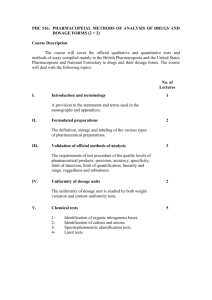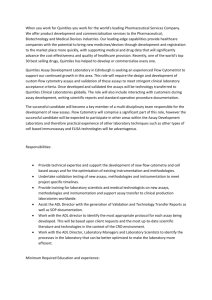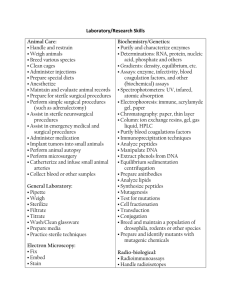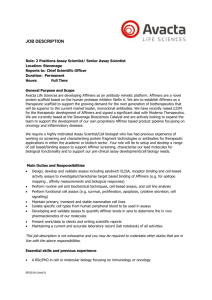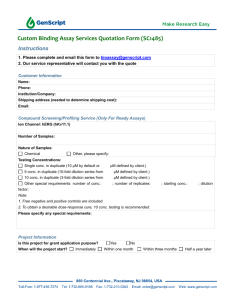2nd-Standards
advertisement
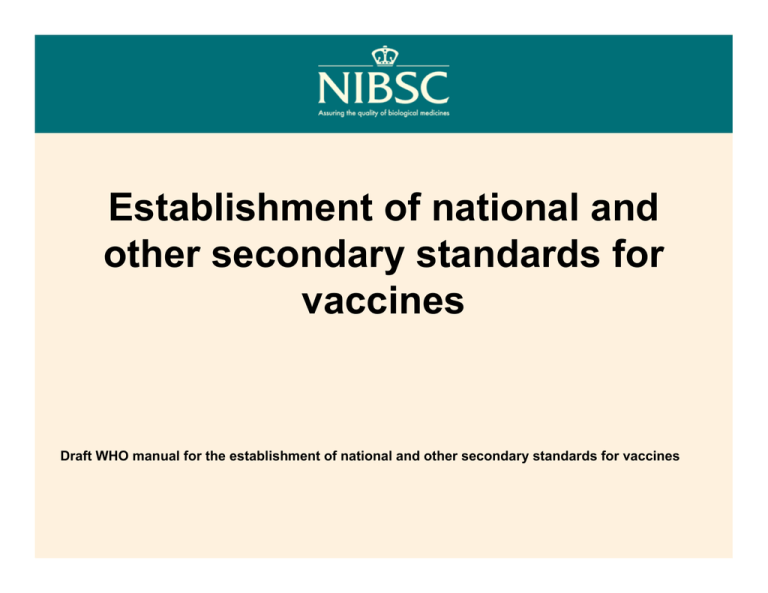
Establishment of national and other secondary standards for vaccines Draft WHO manual for the establishment of national and other secondary standards for vaccines Definition Secondary reference standards Reference standards established by regional or national authorities, or by other laboratories, that are calibrated against and traceable to the primary WHO materials and are intended for use in routine tests. Secondary Standards Vaccines The types of assays - in which standards will be included – – – – – – – – mixtures of proteins carbohydrates, lipids, inactivated microorganisms live attenuated organisms stabilizers, adjuvants, preservatives and other substances. In vitro assays • • • antigen content Identity physicochemical methods In vivo assays • tests for immunogenicity (seroconversion) • protection (challenge tests) Secondary Standards • ISs are likely to be freeze-dried to ensure that they are stable for many years • Secondary standards will be used as working standards – need to be formulated so that they are stable throughout their use – Secondary standards may be liquid or freeze-dried form – likely to be replaced more frequently – Such preparations ideally will be sterile, but materials of low bioburden may be acceptable provided that this does not interfere with activity or affect safety during storage and use General principles • All biological standards or reference materials have certain characteristics essential to their function • Single batch of identical containers, prepared using a process and excipients appropriate for the product • Formally defined unit and quantity, assigned on the basis of appropriately designed studies, using appropriate analytical methodology • Stable with respect to that formally defined quantity. General principles • Traceability - unitage is assigned to the secondary standard relative to the IS is the traceability path, and should be clearly defined. • Uncertainty - formal definition of a secondary standard in terms of the IS must include handling of uncertainty. e.g. acceptable limits attached to the assay of the product. • Value-assignment methodology – The stated traceability path and uncertainty are only valid for the assay methodology used to value-assign the standard – Units of most ISs for vaccines are assigned for specific assays e.g: tetanus and diphtheria toxoids – for bioassays. Therefore it will be necessary to value-assign a secondary standard using a specific assay method. • Stability - stability monitoring against the IS should be incorporated into the stability testing program. Reference material development Development Gate Justification of need Define suitable candidate Trial gate Conduct definitive fill and validate Ready for service (RFS) gate Collaborative study to calibrate, then WHO (ECBS) approval Release IFU, Sales, marketing distribution, storage Flow chart of process Planning – calculation of amount of material required ⇓ Selection of source vaccine ⇓ Characterization of source bulk vaccine ⇓ Processing of final container ⇓ Characterization of candidate secondary standard ⇓ Calibration against IS (including collaborative study) ⇓ Statistical analysis ⇓ Evaluation of estimated stability (if undertaken) ⇓ Preparation of collaborative study report ⇓ Establishment as reference standard ⇓ Preparation of Instructions for use and Distribution Planning The following issues should be considered and, if necessary, a questionnaire sent to all likely users • What kind of assay will the standard be used in? In vitro, in vivo? • How many vials/ampoules will be used in each assay? • Suitability of the secondary standard for testing vaccines from all manufacturers • How many vials/ampoules will be used annually by each user? The number of vials of the standard likely to be used in a year can therefore be determined and an appropriate volume of bulk, or number of vials prepared. (the need for the standard and the likely usage so that the batch of standard produced will last for at least 3-5 years). • The availability of appropriate filling and processing facilities should be available, along with adequate storage facilities. • Planning should also include the number of vials which may be required for calibration and stability studies. Selection of source vaccine Properties of the candidate reference standard • Vaccines produced by different manufacturers do not necessarily behave in the same manner in potency tests • The characteristics of the reference standard should resemble as closely as possible the characteristics of test samples in the assay systems used to test them. • Similarities to the IS Bulk reference standard • • • • • • • • from a single source. It may consist of part or all of a single batch should have a specific activity or concentration sufficient for the purposes of the assays or tests for which it is to be used. If, purity is important, the purity level should be similar to that of the product vaccine. prepare the bulk by pooling material from more than one batch or source, the procedure employed should ensure that the pooled material is mixed thoroughly and is homogeneous. For bulk liquids containing proteins, care should be taken to avoid denaturation during mixing. In addition to any studies that may have been made on the individual batches before pooling, the suitability of the homogeneous blend should be demonstrated. If a preservative is added to a candidate bulk reference standard which is derived from a vaccine not normally formulated with preservative, the added preservative should be shown to not affect the stability, antigenicity, immunogenicity or any other test in which the standard will be used . If excipients derived from human blood are used, information should be available on the viral status of the source material. The bulk vaccine must be stored under suitable conditions before being distributed into final containers. Nature of the secondary standard Standards may be lyophilized, liquid or frozen liquid as appropriate Lyophilized format it allows for easier transportation (usually no need for refrigerated transport) and so offers greater assurance of stability • without unacceptable loss of activity • subsequent reconstitution • Cost Liquid standards • storage stability • Shippment conditions (2-8ºC) -cold chain conditions during transportation Frozen liquid fill This is the most expensive option, requiring packaging in dry-ice and so should only be considered as a last resort. However, for some materials such as live infectious viral reference standards it may be the only viable option. Container Format • The presentation should be evaluated during pilot studies and shown not to affect the characteristics of the standard. • Vials with elastomeric closures are more convenient in terms of their ease of opening e.g. for infectious material -reducing the risk from injury with glass shards. • Reference standards stored in vials with elasotomeric closures, e.g. rubber stoppers may have inferior storage stability to those supplied in flame sealed glass ampoules. • The suitability of the container should be established by accelerated degradation study – – leakages from the rubber closure where liquid standards or frozen liquid standards The suitability of the rubber to the storage conditions • Good quality glass appropriate for pharmaceutical use should be acceptable. • The moisture content – stored in suitable dry conditions and used within established suitable operating shelf-life. Microbial bioburden • Ideally standards should be sterile • minimise the risk of microbial contamination e.g filling facilities with clean room technology • appropriate personal protective equipment • Suitable environmental monitoring, including particle and microbial monitoring of the process area • batch testing of the candidate standard Excipients The formulation of reference standards should reflect closely the test vaccines • It may be necessary to add an excipient to facilitate long term stability or lyophilisation of the standard. e.g. trehalose, human albumin • Examples of stabilisers liquid and frozen state lyophilized state – amino acids - sugars e.g Sucrose, lactose – sugars - proteins – specific stabilisers e.g. metal ions, chelators, detergents • Maintenance of biological activity • No interference on assays Accuracy/consistency of fill • Filling equipment and the precision of filling for freeze-dried standards e.g. International Standards produced at NIBSC are filled within a coefficient of variation of 0.25% for non-viscous and 1% for viscous materials. • These considerations do not apply to standards which are liquid or stored frozen, because there is no opportunity for reconstitution volume errors and volumes can be measured accurately at the time of use. Characterization • Before a candidate standard is calibrated against the IS, its identity should be confirmed. • Appearance – – Freeze dried standards • The appearance of freeze-dried standards is important. • The appearance of the product should be checked across the batch. e.g. through an analysis of the location within the dryer run. Liquid standards • • Liquid standards should be of consistent colour and free of particles or floccules Moisture – For lyophilized standards the residual moisture content is most critical parameter (case by case) • For long term storage stability e.g. IS, <1% • secondary standards. < 3% • Levels of residual moisture above 3% may be acceptable- need suitable stability monitoring studies Characterization Potency/Biologic Activity • demonstration to have retained its integrity, composition and potency, or biological activity, using appropriate methods. • Its activity in the different types of assay in which it will be used should be confirmed. • WHO assays • Compendial assays (e.g. EP or USP) • Other assays should be validated or qualified as appropriate. • Should be assayed against representative batches of vaccine from each supplier. Characterizationfreeze-dried standards • in some cases the bio-activity may be reduced during freeze-drying processes. • Assess loss of activity – by comparing the freeze-dried standard with the frozen base-line material (vaccine before freeze-drying) • Assess the dose-response characteristics – in comparison with both IS and the liquid standard before freeze-drying • Reference standards for in vivo potency tests – define nominal estimation of potency by preliminary calibration in terms of IS • Reference standards for other tests – • identify a suitable range of dilutions to be used Investigate degradation – SDS-PAGE or other suitable physico-chemical methods Calibration against IS • Secondary standards should be calibrated against the current IS in a collaborative study • Laboratories should be selected on the basis of the test under consideration • More participants to generate an adequate number of data sets • Less number of participants- a larger number of independent assays. Documents for organising a collaborative study: e.g. A study protocol ; Form Assay information; Form for report results of each assay Statistical design principles • • The precision reflects the variability in the potency estimates that arises from both experimental and biological sources . – The number of independent assays -to provide a combined relative potency estimate with the desired precision – Individual assays should be designed to provide an assessment of their statistical validity and an estimate of precision of the relative potency estimate. e.g. by replication of samples within each assay to enable estimation of the within-assay variability which is needed to perform the statistical tests for assay validity and calculate confidence limits for the relative potency. – It is preferable that replicates are made from independently repeated dilutions of freshly made solutions and not from sub-sampling from a single dilution series as this could result in underestimation of the within-assay variability, leading to increased stringency in the statistical validity tests and underestimation of the true precision. When designing a series of assays – additional sources of variability such as the order of testing and positional or cage effects – to avoid any systematic bias and ensure accuracy in the calibration. e.g. randomisation of treatments across microtitre plates in a series of assays Statistical analysis • The data generated within each assay undertaken as part of the calibration study should be analysed using the statistical analysis methods that will be used during routine use of the standard for potency determination. • Each independent assay will provide an estimate of the relative potency of the candidate standard against the IS. A confidence interval for the potency gives an indication of the precision with which the potency has been estimated in the assay. The 95% level of confidence is usually used in biological assays. • The statistical validity of the fitted model should be assessed in each individual assay. For example, in the parallel-line and probit models, the linearity and parallelism of the log dose-response relationships are evaluated. • All valid potency estimates for the candidate standard should be combined to produce a final mean potency estimate with confidence limits. In general, a geometric mean is used and the calculation method will depend on whether the estimates are consistent between assays. Stability • Determination of the stability of reference standards – – – • To provide an estimate of the length of time for which the reference standard will remain suitable for its intended purpose under its defined storage conditions To define appropriate conditions for distribution of the reference standard to users To determine the extent to which the reference standard will retain its activity over time after reconstitution On-going evidence of the validity of the prediction is provided by: – – experience with use of the standard as reported by users long term extended stability studies carried out at intervals appropriate for the particular vaccine • If a candidate standard is derived from a batch of commercially produced vaccine, the stability studies undertaken by the manufacturer on that product will give an indication of the expected stability of the product. The stability and suitability for ongoing use as a secondary standard beyond the normal expiry date of the product may be assessed in assays against the IS. • If the standard can be stored frozen at -20°C, to monitor activity throughout the lifetime of a standard would be a comparison with a baseline sample stored at a lower temperature. • Accelerated degradation studies to predict stability, a number of containers should be stored at various temperatures for a period of time. Contents of the collaborative study report • • • • • • Introduction -background and need for the secondary reference standard. Materials- Candidate standard; IS name and code; Other study samples Participants Assay methods including number of assays participants requested to perform Stability data Results – – – – – – – statistical analysis, identity blinded if appropriate the numbers of valid and invalid results. the grounds for any exclusion of results (e.g., non-parallelism or non-linearity). a comparison of assay results from materials tested by different assay methods together with their interpretation comments on factors, e.g. the frequency distribution of the estimates, differences in potency estimates any differences observed between different assay methods. the overall estimates of relative potencies by each assay method The final figure for the overall estimate of the potency • Discussions/conclusions • Proposed value assignment • Tables and figures Responsibilities of the custodian laboratory • Storage of standards under appropriate conditions • Distribution of standards as required under appropriate conditions • Maintenance of complete records on project – – – – – – Bulk standard source and characterisation, before and after filling Collaborative study protocol, results, statistical analysis and report Stability studies Storage, inventory and dispatch of the reference standard Number of ampoules/vials of standard established and distributed Recipients of the standard in case any issues arise • Document feedback from users • Maintain awareness of products being assayed against the standard • Monitor stability by requesting feedback on the use of the standard • Publish the results of the study Instructions for use and labelling • A data sheet/instructions for use should be included in every package of standard – – – – – – – – – • the storage and shipping conditions the potency of the standard the type of assays in which it may be used instructions on the reconstitution of the vaccine statement confirming the stability of the reference standard under conditions of transport relevant safety information available information about stability contact information for feedback on any issues relating to the use, quality or stability of the standard reference to collaborative study report Dispatch of standards Standards should be dispatched under conditions which have been assessed and found appropriate for the stability of the standard so that their potency is not affected during shipping. Batch replacement • Replacement of a secondary standard needs to be planned and timely • Calibration against the IS and not the previous standard, should be followed. The previous standard could be included in the study Documentation to be compiled during a standardisation project • Information on bulk vaccine e.g. source, batch data, correspondence with supplier • Characterization • Technical records (fill logs/details) • Collaborative study raw data • Collaborative study reports • Documentation recording the decision-to-establish by appropriate authority • In-use scientific feedback (including stability) Examples of issues relating to the preparation and characterisation of standards for vaccines produced by different methods Inactivated rabies vaccine • • • • • • • • • • • • • • • • • • • • • • • • • Selection of candidate Strain of virus –current IS and vaccines in production – significant Cell substrate – not significant Method of inactivation – not significant as most beta propiolactone Method of purification –not significant unless it impacts on in vitro potency tests . Characterisation Viral marker testing of human albumin used as excipient Potency of bulk in in vitro and in vivo assays QC Fill CV Residual moisture Appearance Calibration Assays against IS in in vitro + in vivo assays In vitro assays – confidence intervals ??-?? In vivo assays - confidence intervals ??-?? Unitage to be assigned to vaccine activity (in vivo mouse protection studies) + glycoprotein antigen activity (in vitro assays) Stability Reference standard stored at -20°C vs standard stored at -70°C in vitro + in vivo assays The purification method could also affect the stability of the product (impurities in form of degrading enzymes). It may therefore be necessary to consider using the purification method of the vaccine with the longest shelf-life. Prefer 95% confidence intervals Examples of issues relating to the preparation and characterisation of standards for vaccines produced by different methods Measles – a live viral vaccine Measles – a live viral vaccine • • • • • • • • • • • • • • • • • • • Selection of candidate Strain of virus – not significant Cell substrate – not significant Titre – should be comparable with vaccines in routine use If plaque assay used – should produce clear, well defined plaques in assay system Bioburden QC Fill CV Residual moisture Appearance Calibration Titre in parallel with the IS – – – – – • • Strain of virus – not significant Cell substrate – not significant Titre – should be comparable with vaccines in routine use If plaque assay used – should produce clear, well defined plaques in assay system Bioburden QC – – – Fill CV Residual moisture Appearance Calibration – • Stability Reference standard stored at -20°C vs reference standard stored at -70°C in vitro Assay reference standard stored at -20°C against the IS periodically Selection of candidate Titre in parallel with the IS Stability – – Reference standard stored at -20°C vs reference standard stored at -70°C in vitro Assay reference standard stored at -20°C against the IS periodically Examples of issues relating to the preparation and characterisation of standards for vaccines produced by different methods Inactivated bacterial - Whole cell pertussis vaccine • • • • Selection of candidate Strain of bacteria- Phase I contain fims 2 and 3 - significant Concentrated bulk - Opacity e.g. Opacity 180 IOU for 3rd IS and 150 IOU for 4th IS Volume of bulk vaccine required (depend on freeze-drier capacity, normally enough for 5000-10,000 amps plus handling volume) • Characterisation • • • Identity test Presence of fims 2 & 3 Protection assay (potency by Kendrick test) • QC • • • • • Fill CV Residual moisture levels Residual oxygen content Microbial contamination Physical appearance • Calibration • • • Assay (Kendrick test) to assess: - The contents of each ampoule are both sufficient and convenient - To assess comparability of the freeze-dried reference standard and existing standards - Estimate of potency for the proposed standard in terms of International standard/or other standards and assign unitage Stability Reference standard stored at -20ºC evaluated against standard stored at -70ºC in the Kendrick test or by in use monitoring ED50 • • • Purified Component Vaccine Haemophilus influenzae b conjugate vaccine • • • • Selection of candidate Strain of bacteria should be same as used in vaccine production Purity- significant Ribose content-significant • • • Characterisation Identity by in vitro assays Molecular size by in vitro assays • • • • QC Fill CV Residual moisture if lyophilised Appearance • • • Calibration Assays against IS in in vitro assays: Ribose, phosphorus, HPAEC-PAD • • Stability Reference standard stored at -20ºC evaluated against standard stored at -70°C using in vitro assays and against IS. Preparation of collaborative study documentation Invitation/Questionnaire Specimen invitation to participate in a collaborative study Dear………………….. I am writing on behalf of xx to invite you to participate in a collaborative study to establish a national/regional Standard for xx. The aims and provisional structure and timelines of the study are set out in the attached draft study protocol. The study will involve testing the IS and x vaccines in xx many assays May we ask you to: Confirm if you are able to participate in this study. If you are, fill in the attached methodology questionnaire Offer any comments on the proposed study protocol relevant to your contribution. It is normal practice to acknowledge participants as contributors of data rather than co-authors in publications describing the establishment of the standard. Individual participants’ data will be coded and reported “blind” to other participants during the preparation of the study report, and also in subsequent publications. Thank you for considering this request. We hope you can agree to participate. Yours sincerely Questionnaire Name of participant: Address: Telephone Fax E-mail I would like to*/am unable to* participate in the Collaborative Study to assess the suitability of candidate reference material to serve as the National Standard xxxxx. (* delete as appropriate) Include any additional information required for shipping materials Brief description of method Vaccines tested routinely Manufacturer, Trade name, Number of batches per year Signed: NAME Date: Please return to xxxxxxxxxxxxxx FAX xxxxxxxxx email address xxxxxxxxxx Draft Protocol for a collaborative study to assess the suitability of candidate secondary reference material for xxx • Background – • Including need for standard, availability+ information on IS, specifications Information on materials to be included in the study – – – IS Candidate Standard Any other samples – Include any advice on storage, biosafety etc, reconstitution (if freeze-dried) • • Assay Methods – • Design of study – – • Number of assays If more than 2 samples (IS + candidate secondary standard) are being tested, emphasize inclusion of all study samples in each assay. Results and data analysis – – • WHO/pharmacopoeial or method in use in laboratory Supply data sheet so that all essential information can be recorded. A separate data sheet should be completed for each experiment. Timelines Result sheet – Title of study • Participant • Laboratory • Date of assay • Method – WHO, in-house, other • • • • • • Animal assays Dates of immunization, challenge/bleeding, dilutions tested Animal species Number of animals per group Number of animals responding Participant’s calculation of potency of each vaccine in IU • • If sera tested for antibodies by EIA or neutralization - dilutions tested; method, responses (OD, plaque number etc), data from relevant controls The sera tested for antibodies can be in animals, e.g for Diphtheria and Tetanus toxoids by NIH methods - dilutions tested; method, animal species, number of animals per group, number of animals responding, data from relevant controls Participant’s calculation of potency of each vaccine in IU • In vitro assays • • Dilutions tested, response, cut-off (if relevant), data from relevant controls Participant’s calculation of Potency of each vaccine in IU • • Return to xxx; Fax number; e-mail address •
